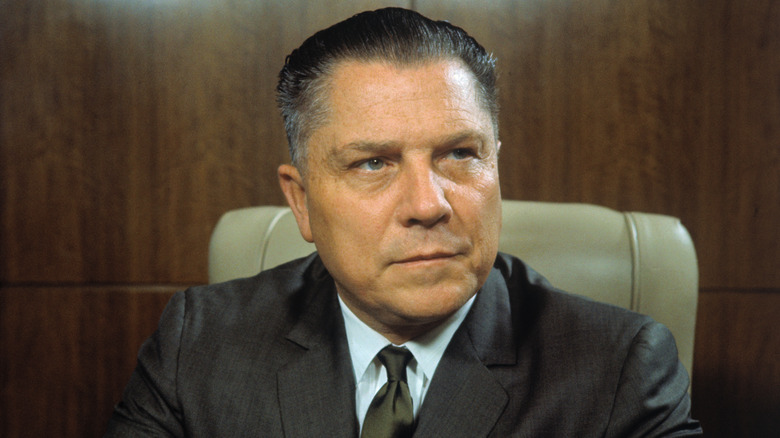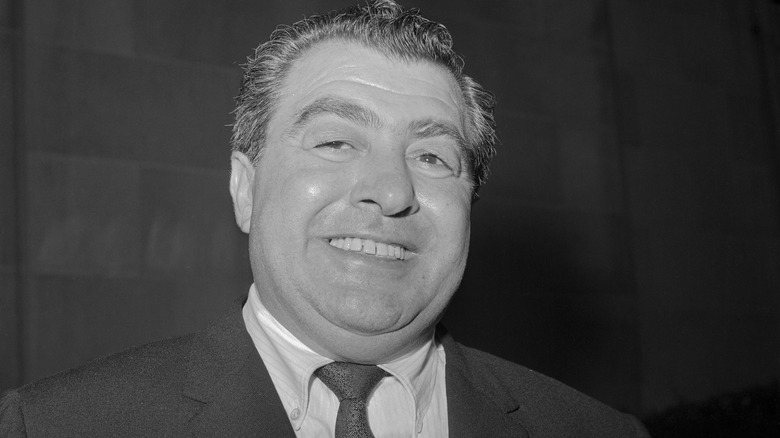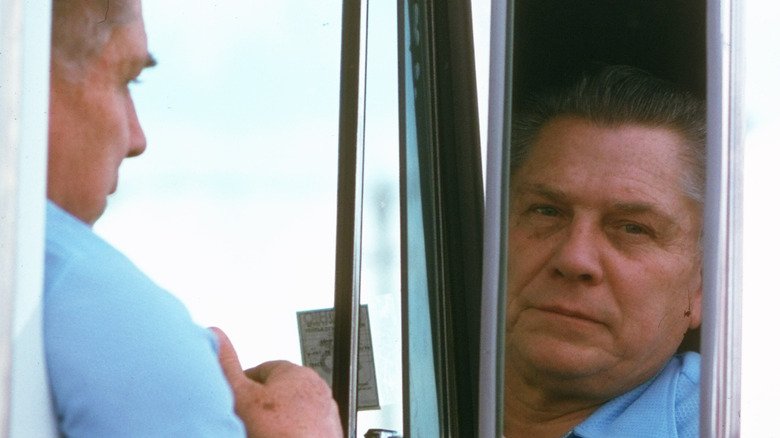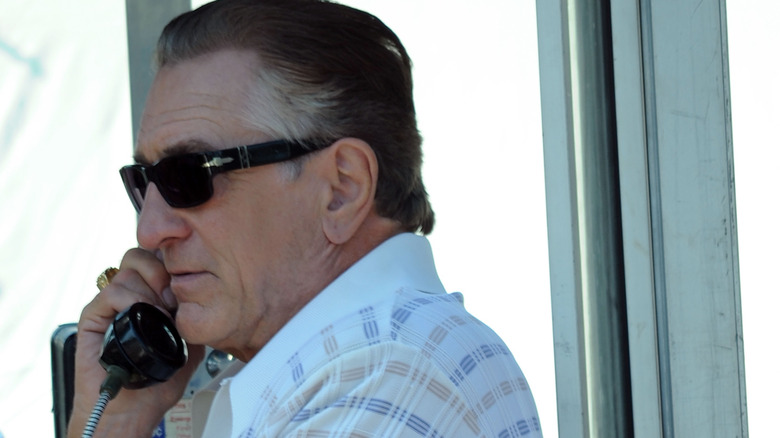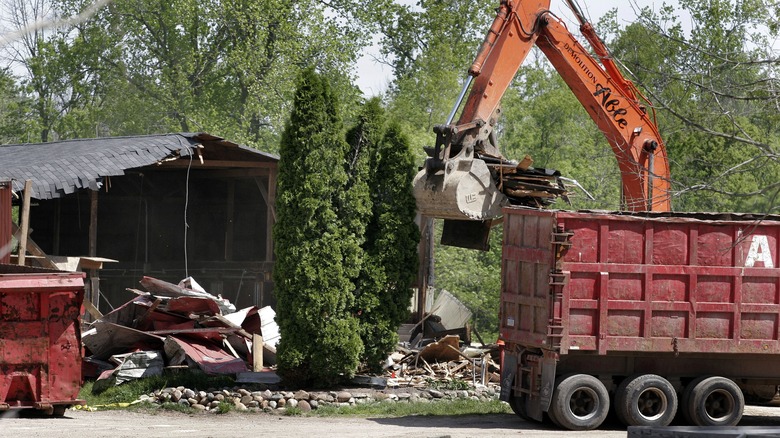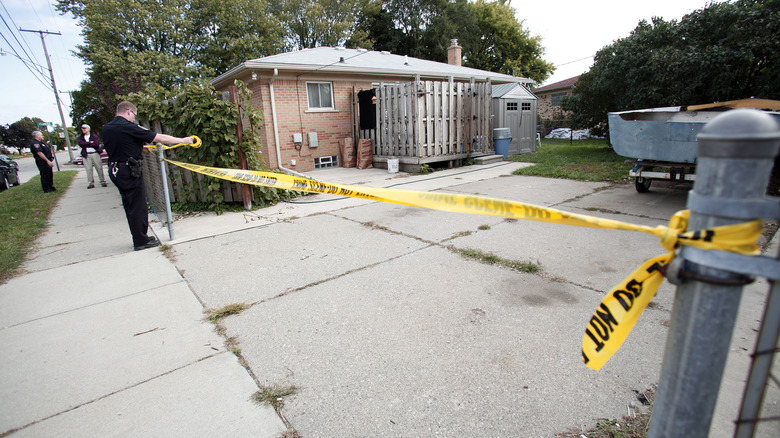Things About Jimmy Hoffa's Disappearance That Don't Make Sense
"Colorful" might be the most tactful descriptor of Jimmy Hoffa's life. Born into poverty, left fatherless at 7, a high school dropout; his beginnings were inauspicious. But in the midst of the Great Depression, Hoffa fell into his true calling: union organizing. Starting as a local business agent, he worked his way up to president of the Teamsters in the 1950s. Along the way, he became a pivotal figure in securing major agreements and swelling the ranks of the Teamsters, which eventually became the largest labor union in America. His bargaining skills made him popular with the rank and file, but in the background, Hoffa rubbed shoulders with organized crime. His own criminal activities made him a bitter enemy of Robert F. Kennedy. After years of ducking charges, he was finally sentenced to prison in 1967, only to have the sentence commuted by Richard Nixon.
And yet, for all the achievements and intrigue that filled Hoffa's time on Earth, his life has arguably been overshadowed by the questions surrounding his death. He was angling to get back into union power when he went to the Machus Red Fox Restaurant in Detroit on July 30, 1975. He called his wife from a payphone to complain that he'd been stood up; two prominent mafiosi were meant to meet with him. It was the last anyone ever heard from Jimmy Hoffa. The trail of evidence regarding his disappearance has been cold for decades, and there are pieces to the story as it's been presented by various researchers, tipsters, and confessions that just don't add up.
It's presumed that the Mafia killed Hoffa
The most commonly accepted theory about Jimmy Hoffa's death is that he was murdered by his former associates in the American Mafia. Hoffa had formed valuable ties with organized crime in his rise to power, but in the years between his sentencing and his commutation, the Mafia came to an agreement with Hoffa's successor at the Teamsters, Frank Fitzsimmons. Hoffa's bid to return to a leadership position in the union could jeopardize their infiltration and pilfering of pension funds, by rocking the cart or by bringing to light mob corruption in the union.
The two mafiosi Hoffa was supposed to have met at the time of his disappearance were Anthony Provenzano, a reported capo of the Genovese crime family, and Anthony Giacalone, a capo in the Detroit mob. The meeting, it's been said, was to be a reconciliation between Hoffa and Provenzano brokered by Giacalone. Hoffa left behind notes about the meeting and complained on the phone to his wife that no one showed at the Machus Red Fox Restaurant, but both mobsters had solid alibis placing them elsewhere.
Provenzano and Giacalone were convicted of unrelated charges shortly after Hoffa's disappearance. Seven other organized crime figures were named as suspects by federal investigators. But if the circumstances suggested a motive for the Mafia to get rid of Hoffa, the evidence was lacking. Witnesses saw Hoffa leave the restaurant in a Mercury Marquis, per The Detroit Free Press, but they couldn't be conclusively identified, and the only trace of Hoffa found in the car was a couple of hairs that took decades to conclusively identify.
Multiple contradictory claims
The investigation into Jimmy Hoffa's death involved over 200 FBI agents and generated more than 16,000 pages of material, according to Click on Detroit. Police dogs found Hoffa's scent in the car witnesses reported seeing him leave in, along with a few hairs that DNA testing confirmed were Hoffa's in 2001. Some witnesses and law enforcement officers believed that the driver of the car was Charles "Chuckie" O'Brien, a longtime Hoffa friend, confidant, and pupil. O'Brien and his family vehemently denied having anything to do with Hoffa's disappearance. His stepson later wrote that O'Brien couldn't have been behind the wheel of the car and that the agents involved in the case eventually accepted his innocence.
Hoffa was declared legally dead in 1982, with authorities no closer to solving his disappearance. That same year saw Charles Allen, Hoffa's former cellmate, claim to the U.S. Senate that Anthony Provenzano had ordered Hoffa's murder. The body, Allen said, was ground to bits and dumped in a Florida swamp. It would be the first of many "confessions" by various figures attached to organized crime concerning the Hoffa case, some of which implicated O'Brien.
Unfortunately for investigators, all of these accounts as to how Hoffa died disagreed with one another. Seven years after Allen's allegations, another figure on the edges of organized crime said that Hoffa was buried under the Giants Stadium. Richard "The Iceman" Kuklinski confessed to killing Hoffa in 2006 and said the body was left in a car sold for scrap. And union official Frank Sheeran told multiple stories about Hoffa's death from the 1990s to his own death in 2003.
Frank Sheeran's claims made headlines but don't add up
Of all the stories told about Jimmy Hoffa's disappearance, Frank Sheeran's have garnered considerable attention. They were the basis for Martin Scorsese's "The Irishman," starring Robert DeNiro as Sheeran. Long before the film came out, Sheeran made headlines and helped push book sales with his confessions. The problem for anyone looking for the truth about Jimmy Hoffa is that Sheeran's story — or rather, stories — are hard to swallow.
For a start, he wasn't believed by people in the know. A local Teamsters leader in Philadelphia and a friend of Hoffa's, Sheeran was in Detroit the day Hoffa vanished and was named as a person of interest in a 1976 report, per Slate. But while there is reason to suspect him of helping to facilitate Hoffa's murder, no credible investigator or journalist familiar with the case believes he did the deed. Sheeran himself denied any involvement in the incident; in the 1990s, he tried to hustle a book deal about his innocence and his supposed insider knowledge that President Richard Nixon had Hoffa killed.
That story evolved into one with Vietnamese contract killers and diagrams showing the possible location of the body. In 2001, Sheeran switched to claims that he was involved, but not the killer; credible news outlets declined the story. Last came his confessions of murder, shared in Charles Brandt's "I Heard You Paint Houses," the source material for "The Irishman." The stories made for good art and entertainment and convinced some in the media, but it hasn't convinced the experts.
There have been multiple claims of where the body is buried
Journalist Selwyn Raab, an expert on the American Mafia, told Slate that 14 different people had confessed to killing Jimmy Hoffa, none of them credible. With the trail cold and with Mafia hits designed to obscure the killers, there's no barrier to making such claims except good taste. And there's no way to prove or disprove anyone's confession, so those claims can keep on coming.
A similar problem has plagued investigators when it comes to tips on the location of Hoffa's body. The tip that he was buried under the Giants Stadium, first made in 1989, was groundless. Frank Sheeran's confession included a house in Detroit where he supposedly hid the body; a 2004 investigation found blood on the floorboards, but it wasn't Hoffa's. Car thieves, prisoners, and anonymous tipsters pointed to farms, fields, and homes, and investigators hunted down every lead. They even razed a horse barn in one search (pictured). But each search came up empty.
A more promising tip came in 2013, when Anthony Zerilli, son of former Detroit mob boss Joe Zerilli, claimed that Hoffa was buried on property belonging to another member of the Detroit crime family. But a three-day search found nothing, and Zerilli was less credible than he seemed at first glance; he was angling for a book deal at the time he gave the tip.
A promising anonymous tip turned up empty
Anthony Zerilli's was the only tip offered on Jimmy Hoffa's resting place that appeared credible at first glance. According to ABC News, in March 2012, author Dan Moldea was contacted by an anonymous tipster, a distant associate of Anthony Giacalone. The informant also shared his story with the FBI and with the police in Roseville, Michigan. According to him, on the night that Hoffa disappeared, a bookmaker for Giacalone was suspiciously pouring concrete at his home on 18710 Florida Street.
If nothing else, the tipster seemed genuinely convinced that his story was true. But Moleda, who had written a book on Hoffa, brushed the lead off. So did the FBI. The house was too exposed to the street for anyone looking to do something nefarious, and the idea that a prominent mob captain would let an associate handle as high-profile a body as Hoffa's strained credulity. The tipster was greatly offended at being rebuffed, but the Roseville police took him seriously enough to investigate the property. And a radar scan did seem to pick up something suspicious.
Based on the scan, a series of holes were drilled into the driveway of 18710 Florida Street, looking for possible human remains. The excavation attracted onlookers and a small media circus. But analysis of the bores failed to find a trace of Hoffa or anyone else. Whatever the tipster's own convictions, his story, like all the others, came to nothing.
